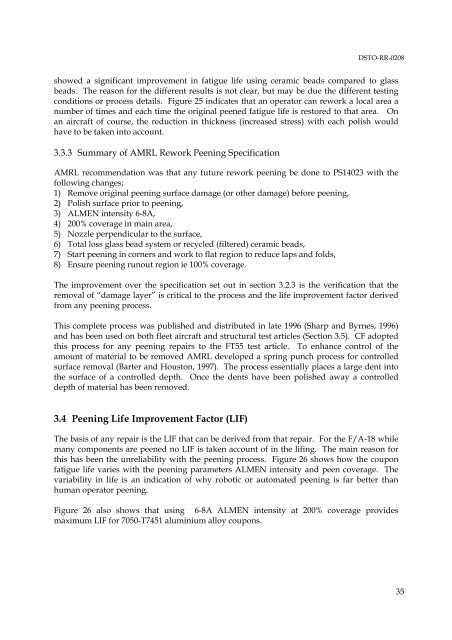The Effect of Peening on the Fatigue Life of 7050 Aluminium Alloy
The Effect of Peening on the Fatigue Life of 7050 Aluminium Alloy
The Effect of Peening on the Fatigue Life of 7050 Aluminium Alloy
You also want an ePaper? Increase the reach of your titles
YUMPU automatically turns print PDFs into web optimized ePapers that Google loves.
DSTO-RR-0208<br />
showed a significant improvement in fatigue life using ceramic beads compared to glass<br />
beads. <str<strong>on</strong>g>The</str<strong>on</strong>g> reas<strong>on</strong> for <strong>the</strong> different results is not clear, but may be due <strong>the</strong> different testing<br />
c<strong>on</strong>diti<strong>on</strong>s or process details. Figure 25 indicates that an operator can rework a local area a<br />
number <str<strong>on</strong>g>of</str<strong>on</strong>g> times and each time <strong>the</strong> original peened fatigue life is restored to that area. On<br />
an aircraft <str<strong>on</strong>g>of</str<strong>on</strong>g> course, <strong>the</strong> reducti<strong>on</strong> in thickness (increased stress) with each polish would<br />
have to be taken into account.<br />
3.3.3 Summary <str<strong>on</strong>g>of</str<strong>on</strong>g> AMRL Rework <str<strong>on</strong>g>Peening</str<strong>on</strong>g> Specificati<strong>on</strong><br />
AMRL recommendati<strong>on</strong> was that any future rework peening be d<strong>on</strong>e to PS14023 with <strong>the</strong><br />
following changes;<br />
1) Remove original peening surface damage (or o<strong>the</strong>r damage) before peening,<br />
2) Polish surface prior to peening,<br />
3) ALMEN intensity 6-8A,<br />
4) 200% coverage in main area,<br />
5) Nozzle perpendicular to <strong>the</strong> surface,<br />
6) Total loss glass bead system or recycled (filtered) ceramic beads,<br />
7) Start peening in corners and work to flat regi<strong>on</strong> to reduce laps and folds,<br />
8) Ensure peening runout regi<strong>on</strong> ie 100% coverage.<br />
<str<strong>on</strong>g>The</str<strong>on</strong>g> improvement over <strong>the</strong> specificati<strong>on</strong> set out in secti<strong>on</strong> 3.2.3 is <strong>the</strong> verificati<strong>on</strong> that <strong>the</strong><br />
removal <str<strong>on</strong>g>of</str<strong>on</strong>g> “damage layer” is critical to <strong>the</strong> process and <strong>the</strong> life improvement factor derived<br />
from any peening process.<br />
This complete process was published and distributed in late 1996 (Sharp and Byrnes, 1996)<br />
and has been used <strong>on</strong> both fleet aircraft and structural test articles (Secti<strong>on</strong> 3.5). CF adopted<br />
this process for any peening repairs to <strong>the</strong> FT55 test article. To enhance c<strong>on</strong>trol <str<strong>on</strong>g>of</str<strong>on</strong>g> <strong>the</strong><br />
amount <str<strong>on</strong>g>of</str<strong>on</strong>g> material to be removed AMRL developed a spring punch process for c<strong>on</strong>trolled<br />
surface removal (Barter and Houst<strong>on</strong>, 1997). <str<strong>on</strong>g>The</str<strong>on</strong>g> process essentially places a large dent into<br />
<strong>the</strong> surface <str<strong>on</strong>g>of</str<strong>on</strong>g> a c<strong>on</strong>trolled depth. Once <strong>the</strong> dents have been polished away a c<strong>on</strong>trolled<br />
depth <str<strong>on</strong>g>of</str<strong>on</strong>g> material has been removed.<br />
3.4 <str<strong>on</strong>g>Peening</str<strong>on</strong>g> <strong>Life</strong> Improvement Factor (LIF)<br />
<str<strong>on</strong>g>The</str<strong>on</strong>g> basis <str<strong>on</strong>g>of</str<strong>on</strong>g> any repair is <strong>the</strong> LIF that can be derived from that repair. For <strong>the</strong> F/A-18 while<br />
many comp<strong>on</strong>ents are peened no LIF is taken account <str<strong>on</strong>g>of</str<strong>on</strong>g> in <strong>the</strong> lifing. <str<strong>on</strong>g>The</str<strong>on</strong>g> main reas<strong>on</strong> for<br />
this has been <strong>the</strong> unreliability with <strong>the</strong> peening process. Figure 26 shows how <strong>the</strong> coup<strong>on</strong><br />
fatigue life varies with <strong>the</strong> peening parameters ALMEN intensity and peen coverage. <str<strong>on</strong>g>The</str<strong>on</strong>g><br />
variability in life is an indicati<strong>on</strong> <str<strong>on</strong>g>of</str<strong>on</strong>g> why robotic or automated peening is far better than<br />
human operator peening.<br />
Figure 26 also shows that using 6-8A ALMEN intensity at 200% coverage provides<br />
maximum LIF for <strong>7050</strong>-T7451 aluminium alloy coup<strong>on</strong>s.<br />
35

















